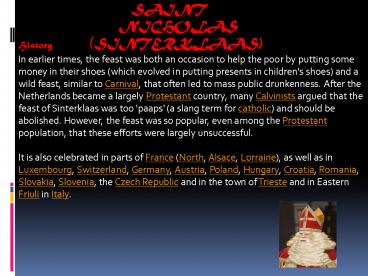Saint Nicholas (Sinterklaas) - PowerPoint PPT Presentation
Title:
Saint Nicholas (Sinterklaas)
Description:
... on December 25 and Tweede Kerstdag (Second Christmas Day) on December 26, both of which are public holidays. ... an annual parade to celebrate the events ... – PowerPoint PPT presentation
Number of Views:92
Avg rating:3.0/5.0
Title: Saint Nicholas (Sinterklaas)
1
Saint Nicholas(Sinterklaas)
- History
- In earlier times, the feast was both an occasion
to help the poor by putting some money in their
shoes (which evolved in putting presents in
children's shoes) and a wild feast, similar to
Carnival, that often led to mass public
drunkenness. After the Netherlands became a
largely Protestant country, many Calvinists
argued that the feast of Sinterklaas was too
'paaps' (a slang term for catholic) and should be
abolished. However, the feast was so popular,
even among the Protestant population, that these
efforts were largely unsuccessful. - It is also celebrated in parts of France (North,
Alsace, Lorraine), as well as in Luxembourg,
Switzerland, Germany, Austria, Poland, Hungary,
Croatia, Romania, Slovakia, Slovenia, the Czech
Republic and in the town of Trieste and in
Eastern Friuli in Italy.
2
Arrival
Sinterklaas traditionally arrives each year in
mid-November (usually on a Saturday) by steamboat
from Spain (even though the bishop was originally
from Asia Minor). Some suggest that gifts
associated with the holy man such as Mandarin
oranges led to the misconception that he must
have been from Spain. He is then paraded through
the streets, welcomed by cheering and singing
children. This event is broadcasted live on
national television in the Netherlands and
Belgium. His Zwarte Piet assistants throw candy
and small, round, ginger bread-like cookies,
either "kruidnoten" or "pepernoten," into the
crowd. The children welcome him by singing
traditional Sinterklaas songs. Sinterklaas also
visits schools, hospitals and shopping centers.
After this arrival all towns with a dock have
their own "intocht van Sinterklaas" (arrival of
Sinterklaas). Local arrivals usually take place
on Sunday, the day after he arrives in the
Netherlands or Belgium. In places a boat cannot
reach, Sinterklaas arrives by train, bus, horse,
or even carriage. Presents
Traditionally, in the weeks between his arrival
and December 5, before going to bed children put
their shoes next to the fireplace chimney of the
coal fired stove or fireplace, or, in modern
times, next to the central heating, with a carrot
or some hay in it and a bowl of water "for
Sinterklaas' horse," and sing a Sinterklaas song
the next day they will find some candy or a small
present in their shoes, supposedly thrown down
the chimney by a Zwarte Piet or Sinterklaas
himself. When a house has no chimney, Sinterklaas
is said to enter using his special key that fits
on every door in the Netherlands. Presents are
often accompanied by a simple poem, saying
something about the child or containing a hint to
the nature of the present. Sinterklaas often uses
these poems to reprimand and tease children about
bad habits or behavior.
3
Christmas in Netherlands
Christmas, the traditional Christian holiday
commemorating the birth of Jesus Christ, is
celebrated over two days in the Netherlands, i.e.
Eerste Kerstdag (First Christmas Day) on December
25 and Tweede Kerstdag (Second Christmas Day) on
December 26, both of which are public holidays.
People buy Christmas trees, and decorate them
with kerstkransjes (Christmas wreath cookies),
glass balls, gilded nuts, ribbons, glittery pine
cones, frosted bells, and red and white candles.
Many people place beautiful Advent star lights in
their windows.
The main square of every city has its own
brightly lit Christmas tree. Twinkly lights
shaped like bells and stars, and garlands are
strung over many of the charming old streets,
adding instant Christmas cheer during the darkest
days of the year.
Families spend the day together on the 25th. Some
attend a late night Christmas service at church,
after which they eat breakfast at home, often in
the early hours. In an increasingly irreligious
Holland, however, most people just relax at home
and eat themselves silly. Breakfast usually
consists of a brunch with a kerststol (fruited
Christmas loaf) with butter, and luxury breakfast
items like smoked salmon, pates, fancy bread
rolls, etc.
4
Kermesse
Kermesse or kermis, is a term derived from 'kerk'
(church) and 'mis' (mass) that became borrowed in
English and French, originally denoting the mass
said on the anniversary of the foundation of a
church and in honour of the patron.
The first kermesse was an annual parade to
celebrate the events of 1370 (some sources say
1369) in Brussels, when all the Jews of the city
were burnt alive for having profaned a basket of
communion hosts, which bled when stabbed.
These festivities still survive in the form of
funfairs, while the old allegorical
representations are now uncommon. The funfair on
the Vrijdagmarkt in Ghent coincides with the
10-day long Gentse Feesten (Ghent Festivities)
which are held across the entire inner city
around the 21st of July (Belgian national
holiday).































